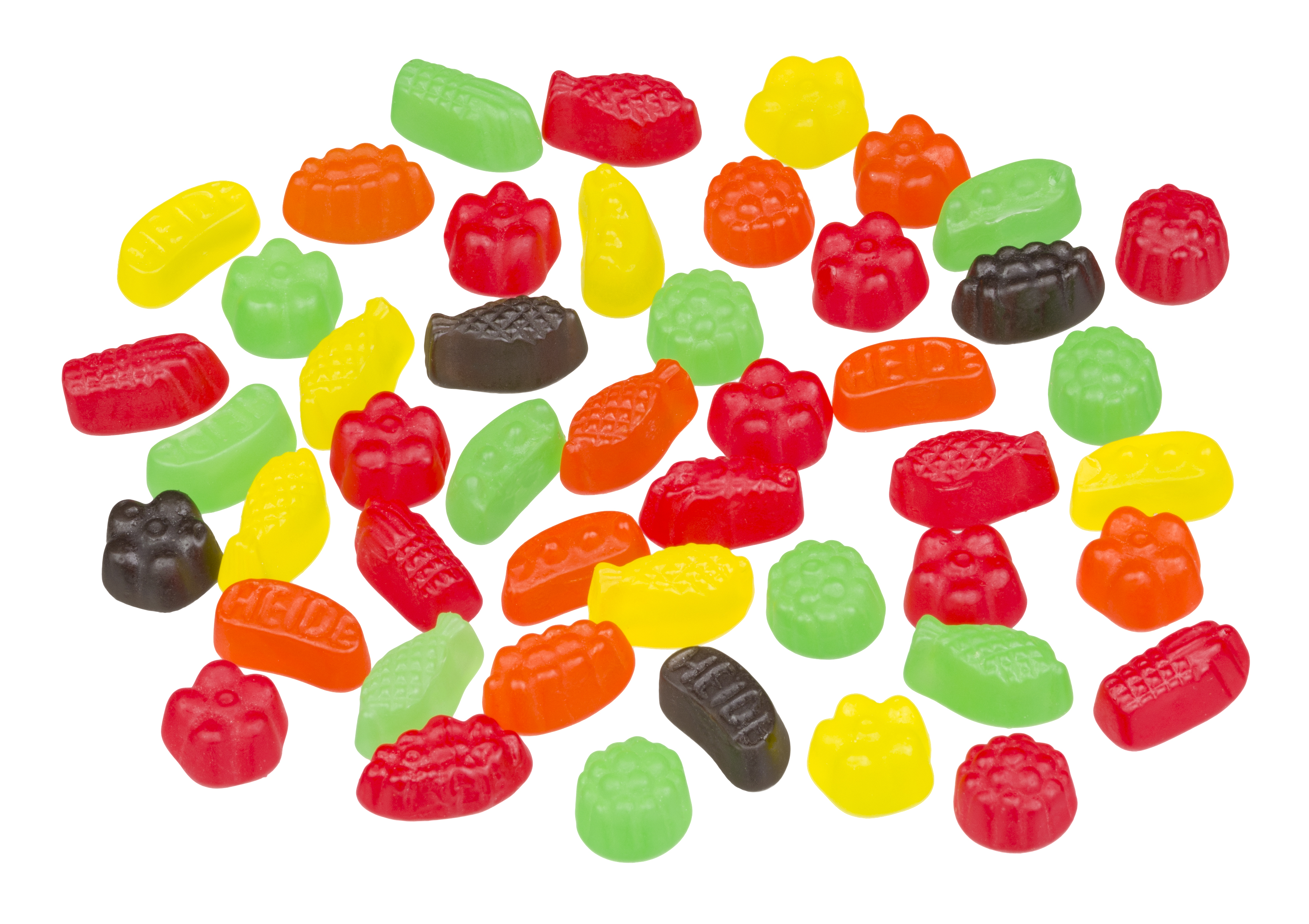|
Jujyfruit
Jujyfruits are a chewy, gumdrop-like starch-based candy, manufactured by Heide Candy Company, a subsidiary of Ferrara Candy Company. Jujyfruits began production in 1920. They were popular in movie houses along with Heide's other gummy candy, Jujubes. Description The Jujyfruits shapes are Asparagus Bundle, Banana, Grape Bundle, Pea Pod, Pineapple, Raspberry, and Tomato. The banana shape is stamped with "HEIDE." Fruity flavors correspond to the colors (not the shapes) and include raspberry (red), anise/ licorice (black), lime (green), orange (orange), and lemon (yellow). The candies are firm and harden with age or when chilled. A sour variety is also available. Until January 1999, the green sweets were mint flavored. Hershey (the parent company at the time) changed them to lime after a customer survey found that mint was not a popular flavor. Ingredients , the ingredients listed on Jujyfruits boxes are: *Corn syrup *Sugar *Modified and unmodified cornstarch * Natura ... [...More Info...] [...Related Items...] OR: [Wikipedia] [Google] [Baidu] |
Heide Candy Company
Heide Candy Company is a subsidiary of candy manufacturer Ferrara Candy Company. History The Henry Heide Candy Company was founded in 1869 by Henry Heide, who immigrated to the United States from Obermarsberg, Westphalia, Germany. Jujyfruits began production in 1920. Original flavors included lilac, violet, rose, spearmint, and lemon. Rose and spearmint have been changed to cherry and lime, as a result of flavor availability." The current flavor lineup is lemon (yellow), anise (black), orange (orange), lime (green), and raspberry (red). They were popular in movie houses along with Heide's other gummy candy, Jujubes. On December 13, 1931, Henry Heide died in New York City. Henry's son, Andrew Heide, took over the business and became the company's fourth president in 1957. He moved the production facility from Hudson Street in New York City to New Brunswick, New Jersey New Brunswick is a city (New Jersey), city in and the county seat, seat of government of Middlesex ... [...More Info...] [...Related Items...] OR: [Wikipedia] [Google] [Baidu] |
Ferrara Candy Company
The Ferrara Candy Company is an American candy manufacturer, based in Chicago, Illinois, and owned by the Ferrero Group. The company was formed from a 2012 merger of the Illinois-based Ferrara Pan Candy Company and Minnesota-based Farley's & Sathers Candy Company. Ferrara's product line includes the brands of Ferrara-branded pan candy (such as Lemonheads, Atomic Fireballs, Red Hots, and Original Boston Baked Beans) and those of Farley's & Sathers (such as Brach's, Chuckles, Jujyfruits, and Now and Later). In November 2017, The Ferrero Group announced that they were going to acquire the company, which was finalized in December 2017. In 2018, Ferrara's parent company Ferrero SpA purchased Nestlé's U.S. candy line for $2.8 billion and handed responsibility for most products to Ferrara. Former Nestle products now distributed in the U.S. by Ferrara include Butterfinger, Crunch, Baby Ruth, Raisinets, Nips, Laffy Taffy, and hard candy (such as Spree and Everlasting Gobstopper) for ... [...More Info...] [...Related Items...] OR: [Wikipedia] [Google] [Baidu] |
Jujube (confectionery)
Jujube ( or ; also known as jube or juju) is a Gummy candy, gummy type of candy drop. History A recipe for "pate de jujubes" was published in 1709. The recipe called for gum arabic, sugar, and the date-like jujube fruit. In 1853, both "ju ju paste" and "ju ju drops" were sold by confectioners. Later, recipes used various flavorings instead of jujube fruits. See also * Candy Raisins * Chuckles * Gumdrop * Jelly bean * Jujube fruit * Jujyfruits * Midget Gems (also known as Mini Gems) * Mint (candy) * Wine gum References External links Jujyfruit (Jujubes) Candy WebsiteOfficial Ferrara Candy Website {{DEFAULTSORT:Jujube (Confectionery) Brand name confectionery Candy Farley's & Sathers Candy Company brands Ferrara Candy Company brands Gummi candies ... [...More Info...] [...Related Items...] OR: [Wikipedia] [Google] [Baidu] |
Sugar
Sugar is the generic name for sweet-tasting, soluble carbohydrates, many of which are used in food. Simple sugars, also called monosaccharides, include glucose, fructose, and galactose. Compound sugars, also called disaccharides or double sugars, are molecules made of two bonded monosaccharides; common examples are sucrose (glucose + fructose), lactose (glucose + galactose), and maltose (two molecules of glucose). White sugar is a refined form of sucrose. In the body, compound sugars are hydrolysed into simple sugars. Longer chains of monosaccharides (>2) are not regarded as sugars, and are called oligosaccharides or polysaccharides. Starch is a glucose polymer found in plants, the most abundant source of energy in human food. Some other chemical substances, such as glycerol and sugar alcohols, may have a sweet taste, but are not classified as sugar. Sugars are found in the tissues of most plants. Honey and fruits are abundant natural sources of simple sugars. Suc ... [...More Info...] [...Related Items...] OR: [Wikipedia] [Google] [Baidu] |
Sour
The gustatory system or sense of taste is the sensory system that is partially responsible for the perception of taste (flavor). Taste is the perception produced or stimulated when a substance in the mouth reacts chemically with taste receptor cells located on taste buds in the oral cavity, mostly on the tongue. Taste, along with olfaction and trigeminal nerve stimulation (registering texture, pain, and temperature), determines flavors of food and other substances. Humans have taste receptors on taste buds and other areas, including the upper surface of the tongue and the epiglottis. The gustatory cortex is responsible for the perception of taste. The tongue is covered with thousands of small bumps called papillae, which are visible to the naked eye. Within each papilla are hundreds of taste buds. The exception to this is the filiform papillae that do not contain taste buds. There are between 2000 and 5000Boron, W.F., E.L. Boulpaep. 2003. Medical Physiology. 1st ed. Elsevier Sc ... [...More Info...] [...Related Items...] OR: [Wikipedia] [Google] [Baidu] |
The Hershey Company
The Hershey Company, commonly known as Hershey's, is an American multinational company and one of the largest chocolate manufacturers in the world. It also manufactures baked products, such as cookies and cakes, and sells beverages like milkshakes, as well as other products. Its headquarters are in Hershey, Pennsylvania, United States, which is also home to Hersheypark and Hershey's Chocolate World. It was founded by Milton S. Hershey in 1894 as the Hershey Chocolate Company, which is a subsidiary of his Lancaster Caramel Company. The Hershey Trust Company owns a minority stake but retains a majority of the voting power within the company. Hershey's chocolate is available across the United States, and in over 60 countries worldwide.Booksense.com . Retrieved June 30, 2006. It has three large |
Mint (candy)
A mint or breath mint is a food item often consumed as an after-meal refreshment or before business and social engagements to improve breath odor. Mints are commonly believed to soothe the stomach given their association with natural byproducts of the plant genus ''Mentha''. Mints sometimes contain derivatives from plants such as peppermint oil or spearmint oil, or wintergreen from the plant genus ''Gaultheria''. However, many of the most popular mints citing these natural sources contain none in their ingredient list or contain only trace amounts. History The production of mints as a discrete food item can be traced back to the 18th century with the invention of Altoids. The popularity of mints took off in the early 20th century, with the advent of mass urbanization and mass marketing. Advertising for mints focused on their convenience, and on the socially isolating effects of bad breath. These advertisements targeted young people generally, and young women particularly. Mints ... [...More Info...] [...Related Items...] OR: [Wikipedia] [Google] [Baidu] |
Corn Syrup
Corn syrup is a food syrup which is made from the starch of corn (called maize in many countries) and contains varying amounts of sugars: glucose, maltose and higher oligosaccharides, depending on the grade. Corn syrup is used in foods to soften texture, add volume, prevent crystallization of sugar, and enhance flavor. Corn syrup is not the same as from high-fructose corn syrup (HFCS), which is manufactured from corn syrup by converting a large proportion of its glucose into fructose using the enzyme D-xylose isomerase, thus producing a sweeter substance. The more general term glucose syrup is often used synonymously with corn syrup, since glucose syrup in the United States is most commonly made from corn starch. Technically, glucose syrup is any liquid starch hydrolysate of mono-, di-, and higher-saccharides and can be made from any source of starch: wheat, tapioca and potatoes are the most common other sources. Commercial preparation Historically, corn syrup was produced ... [...More Info...] [...Related Items...] OR: [Wikipedia] [Google] [Baidu] |
Artificial Flavor
A flavoring (or flavouring), also known as flavor (or flavour) or flavorant, is a food additive used to improve the taste or smell of food. It changes the perceptual impression of food as determined primarily by the chemoreceptors of the gustatory and olfactory systems. Along with additives, other components like sugars determine the taste of food. A flavoring is defined as a substance that gives another substance taste, altering the characteristics of the solute, causing it to become sweet, sour, tangy, etc. Although the term, in common language, denotes the combined chemical sensations of taste and smell, the same term is used in the fragrance and flavors industry to refer to edible chemicals and extracts that alter the flavor of food and food products through the sense of smell. Owing to the high cost, or unavailability of natural flavor extracts, most commercial flavorings are "nature-identical", which means that they are the chemical equivalent of natural flavors, but c ... [...More Info...] [...Related Items...] OR: [Wikipedia] [Google] [Baidu] |
Cornstarch
Corn starch, maize starch, or cornflour (British English) is the starch derived from corn (maize) grain. The starch is obtained from the endosperm of the kernel. Corn starch is a common food ingredient, often used to thicken sauces or soups, and to make corn syrup and other sugars. Corn starch is versatile, easily modified, and finds many uses in industry such as adhesives, in paper products, as an anti-sticking agent, and textile manufacturing. It has medical uses as well, such as to supply glucose for people with glycogen storage disease. Like many products in dust form, it can be hazardous in large quantities due to its flammability—see dust explosion. When mixed with a fluid, corn starch can rearrange itself into a non-Newtonian fluid. For example, adding water transforms corn starch into a material commonly known as oobleck while adding oil transforms corn starch into an electrorheological (ER) fluid. The concept can be explained through the mixture termed "cornflour ... [...More Info...] [...Related Items...] OR: [Wikipedia] [Google] [Baidu] |
Natural Flavor
A flavoring (or flavouring), also known as flavor (or flavour) or flavorant, is a food additive used to improve the taste or smell of food. It changes the perceptual impression of food as determined primarily by the chemoreceptors of the gustatory and olfactory systems. Along with additives, other components like sugars determine the taste of food. A flavoring is defined as a substance that gives another substance taste, altering the characteristics of the solute, causing it to become sweet, sour, tangy, etc. Although the term, in common language, denotes the combined chemical sensations of taste and smell, the same term is used in the fragrance and flavors industry to refer to edible chemicals and extracts that alter the flavor of food and food products through the sense of smell. Owing to the high cost, or unavailability of natural flavor extracts, most commercial flavorings are "nature-identical", which means that they are the chemical equivalent of natural flavors, but c ... [...More Info...] [...Related Items...] OR: [Wikipedia] [Google] [Baidu] |








